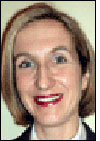May 09, 2012Managers at the Killure Bridge Nursing Home, located in Waterford, Ireland, strive to make their residence a place where its inhabitants—some of whom have dementia—can feel free to walk around the facility without a risk to their safety. The nursing home, built in 2004, utilized a nurse-call system to send messages to staff members, but wanted real-time locating functionality that would provide employees with a view of every occupant's location, and that would issue an immediate alert in the event that a resident wandered away. The solution—consisting of Ekahau RFID tags and real-time location system (RTLS) software, as well as Motorola Solutions Wi-Fi access points—and was installed by Dimension Network Systems, a Dublin systems integration company.
About 10 of the nursing home's 79 residents suffer from dementia, says Mary Burke, Killure Bridge Nursing Home's director of care, and occasionally wander through the doors. Therefore, to ensure the residents' safety, workers regularly walked through the facility searching for individuals at risk of wandering. The concern, she says, was that staff members could spend time looking for someone inside the facility who had actually slipped out the door and could be in harm's way. The nursing home thus sought a solution that could sound an alarm before such an incident could occur. Such a system would not only increase safety, Burke says, but also save time that the staff previously spent walking throughout the building searching for residents. "We have three or four people who are very high-risk," she states. "If I haven't seen them for an hour or so, I often want to do a check."
In addition, the facility wanted to be able to track its own staff—for example, locating a particular nurse or other employee—and allow workers to find Burke when necessary.
The Ekahau system that Dimension Network Systems provided, in November 2011, consists of 10 T301BD badge tags for staff members and 10 T301W wristband tags for residents. Each of the 20 tags transmits an ID number at regular intervals via a Wi-Fi connection, to multiple Wi-Fi access points connected to a Motorola RFS6000 wireless local area network (LAN) switch, and installed throughout the facility by Dimension Network Systems. Ekahau's Positioning Engine software calculates the tag's location based on the data received by the Wi-Fi nodes. Ekahau Vision software then manages the read data, linking a tag's ID number with the individual who has that tag, and determining when an alert may need to be triggered, explains Siobhan Stynes, Dimension Network Systems' director. Throughout the day, the software also stores each person's location history.
Burke says if she needs to locate a staff member, she can access the software via a PC and select that individual. The system will then display the worker's location, such as the room in which he or she is located. What's more, Burke can transmit a message to that person's tag by typing text into the software, which is then forwarded to the tag as a text message on its digital display—for example, "report to Room 20."
Furthermore, the system enables the nursing home to conduct a study of how workers' time is spent during evening hours. For instance, the solution detects the amount of time that each employee spends within specific locations throughout the night. If a problem is identified—such as a particular staff member spending excessive time seated without checking on residents—management can then work to re-educate the staff.
The technology, Burke says, "is working very much the way we expected." Employees are happy with it, she adds, because it saves time they would otherwise spend searching for residents and other workers. Families of residents wearing the wristbands willingly offered their consent to allow the system to be used for tracking their loved ones, she reports, since it improves security and safety by preventing those individuals from wandering.
Initially, Burke says, the wristbands were easy to remove, and residents occasionally took them off. However, she adds, the versions currently in use are more secure since they are difficult to take off. The new wristbands can be worn during showers or bathing without needing to be removed.


